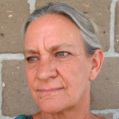(I wrote this series, because, for years, people have asked me how I got so ‘green’. Hopefully this will provide some insight and give you ideas about how to live simply and appreciate the natural world of which we are all a part.)
I lead a simple life. Cerebrally and emotionally, it’s not so simple—but materialistically, it is.
The 50s & 60s
I grew up in a well-to-do, materialistic, social-climbing, racist, greedy, post World War II suburban dentist’s family. I never felt like I fit in, but when you’re a child, you have to go along. Private schools and country clubs were not my choices, but I gleaned what I could from them and have good memories.
When I was home, I could usually be found playing outside in the woods, smelling skunk cabbage and catching frogs in the brook. This was where I belonged, not in some fabricated ‘cee-ment pond,’ as Jed Clampett called it. Indoors, I was creative, digging through my mother’s sewing supplies and magazines to make collages, or I was holed up in my room writing or designing houses. I rarely watched TV. I was a black sheep.
Meanwhile, kids a little older than me also from wealthy families were rebelling against money, greed, corporations and racism. This was one aspect of the hippie era, glorious and enlightening times. The emphasis was on simplicity and spirituality, not money, and the historic revolution was underway.
The 70s
When I came of age, I let go of years of right-wing programming. I finally had the chance to express my Self. I held onto what I had – creativity, writing and a natural love of the outdoors – and I observed and assimilated what resonated with me to fill the vacuum. Much of that today is called ‘green.’ I can forgo today’s popular and necessary movement to ‘go green,’ having been green for most of my adult life.
My first job in college was on a farm. I loved being in between rows of vegetables pulling weeds. A special calmness came over a troubled 19 year old doing mindless work. I had never eaten homegrown food before, either. That was a blessing at harvest time and changed my life.
The ‘oil embargo’ of 1974 taught me to be frugal, since gas was rationed every other day, and stations were closed on Sunday. The price of gas had shot up from 30 cents to 75 cents, which was outrageous. Even though I drove a VW, I learned to cut back on other things, like food and utilities. Sound familiar?
My boyfriend and I were out of work for winter, squeaking by on unemployment and food stamps. Living in rural New Hampshire, we traveled to the state capitol every two weeks to sign for stamps. We budgeted that money wisely, creating menus and ‘shopping to the menu’ when we got to the city. This is a tactic I still use, because it keeps me from frivolous food purchases, stretching a dollar.
In spring, we moved to New York to get work. I was a bookkeeper for a while, but being inside all day drained my soul. This office also had all south-facing glass and no operable windows, so we ran ventilators in winter to cool it off. In summer, I wanted fresh air and to bring the outdoors in. Frustrated and suffocated, I didn’t last there long.
Growing Into My Niche
My mother did not teach me how to cook. About this time, someone suggested The Joy of Cooking, which was an excellent place to start. I think the original version of this was from the 30s, and I remember reading how to harvest and prepare your chicken to roast it! My suburban upbringing did not prepare me for this information, but I was fascinated by growing your own meat and other foods.
Then I discovered another book, modern, meat-free and radical – Diet for a Small Planet by Frances Lappe. The first half was a political discourse in not eating meat. She touched on world hunger and poverty, ecology, the American diet and the waste of water and energy in the grain-to-beef equation. The second half was recipes that would fill your proteins needs through plants. Wow! I forgot about harvesting chickens, and cooked from this book until the pages were yellowed, when I was forced to buy another copy.
We moved upstate to a cabin on a converted 200 acre estate. We bought a high-tech woodstove and started heating with wood to cut our electric bill and rebel against Con Edison. I started my own organic garden, recalling those sweet days on the farm in college. I also bought a new car, a Toyota Corolla, which got 30+ mpg, a major selling point. I hadn’t forgotten about running out of gas in front of the station during rationing.
I loved my simple country life, but in 1978, I left rural New York and went back to New Hampshire to deeper simplicity.
photo copyright Nan Fischer
Stay tuned for part two!
Adapted from the original on my blog, desert verde.











Read 11 comments and reply